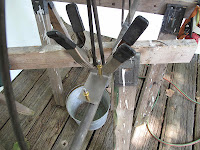To form the bearing strap I started with a 6" strip of steel with bend lines marked 17/32" either side of center. As with the hinge block clips I'm forming the bends with my sheet metal pliers with a radius filed on the edges.The bends are made to form a triangle.
The formed strip is slipped over one side of the sheet metal pliers with the jaws open. The pliers are setting in the vise to provide something to pound against.
The plan is to use my 5/8" deep socket as a form tool to pound the curved bearing surface into the strip. I found that after just starting the bend I needed to clamp the sides tightly to keep the sides spaced correctly and parallel. Once it's done you have a nice bearing.
I did find I needed to twist the legs slightly to square them up to the bearing surface. I clamped each part to a piece of 1" tubing and the adjusted the legs to square.
I made this little fixture from a piece of aluminum angle. There is a 3/16" bolt which goes through the strip in front of the stabilizer rear spar. A small piece tubing gets welded to front of the spar for this bolt. The purpose of the fixture is to punch the bolt holes in the legs of the bearing strips.
The tab bent over on the fixture is a stop to locate the bearing relative to the hole so the 2 holes are on a line perpendicular to the legs.
With the holes punched the legs can be trimmed to length and the bearings are ready to weld to the stabilizer. I believe the factory probably welded the small tube and bearing together as an assembly and slipped them over the spar during assembly into the stabilizer jig. It would make welding much easier. I've got the stabilizer assembled so I'll just need to be careful welding all this in place.
























































